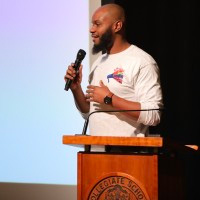“Hummus…what’s that?” I remember asking my 9th grade white peers as we sat around the lunch table for the first time, aware of their looks and smirks because I did not know what it was. In my Afro-Caribbean immigrant household, hummus was not on the menu. This was one of the first othering experiences I had as a Black student at a predominantly white independent school. And it certainly was not the last.
Not knowing about hummus wasn’t the only thing that set me apart. When I stepped off the school bus for the first time as a high school student, I quickly realized that I had never been in such proximity to white kids. My limited interaction with white people centered mostly around attending my mother’s annual workplace holiday party, where I would exchange awkward hellos with her colleagues and their kids while I waited to receive my gift from the company Santa. As I walked around my independent school campus, I felt hyper-aware of my clothing, walk, and accent, and I worried all day if there would be more questions to which everyone knew the answer but me. I often returned home feeling unsure, self-conscious, and certain that I did not fit in.
For four years, I tried on different versions of myself, hoping that each iteration of Dwight would provide relief to my persistent desire to fit in and somehow earn acceptance. Years later, I realized that I was consistently exhausted because I was actively changing my dress, music, humor, not recognizing that the things that I claimed as mine were really theirs. And I have since wondered what my school and peers could have done differently so that I could just be me. Nowadays, most schools tout their inclusion––the I in DEI––with inflated stats and posed brochure pictures, and still most kids feel like I did because schools are missing a key component. We need to name and be more intentional about adding “belonging” to the discussion.
To be Seen, Heard, Valued, and Loved
In 2018, I had the pleasure of attending a workshop led by Dena Simmons, the former assistant director of Yale’s Center for Emotional Intelligence, during which she shared that she does not like the word “inclusion.” Surprised by her comment, I wanted to learn more––all of the equity practitioners in the room either had inclusion in their title or worked at schools whose mission statement has the word inclusion in it. Similarly, I’ve been trained to include inclusion in my work and have often used it as a way to get more folks (read: white people) involved. Simmons talked about how she has been included in places and spaces and simultaneously knew that she did not belong, how her experience in such spaces did not align with the place’s intention of being more inclusive––which often meant little more than having more Black and brown people physically present.
Her comments resonated deeply with me as a member of the independent school community for seventeen years––four as a student, thirteen as a faculty member and administrator, and four concurrent years as a parent––and were a turning point for how I think about my work as an equity practitioner and what DEI work means in independent schools. Since then, I have shifted my attention to highlight and promote belonging, defining it as: to be seen, heard, valued, and loved.
Making Belonging a Priority
I wish my high school self could have felt that deep sense of belonging I often feel when I stroll into the large auditorium for the opening session at the NAIS People of Color conference. I bring all of myself into the space and don’t feel the need to do anything special to try to fit in because the environment and those present have already done the work to welcome all of me. PoCC in 2019 felt different. There has been a steady and significant increase in the number of white participants at PoCC, who attend as allies (sidenote: I believe that white people should be aiming to be accomplices because there is both risk and collaboration baked into equity work; whereas, being an ally can often be performative and inconsistent). This focus on inclusiveness deeply challenged my sense of belonging at the conference. There were times when I felt invisible, when I did not feel welcomed in a space intended for me, when my voice––along with other voices from folks of color––was not heard. We asked our white colleagues to be mindful of the space, both physically and emotionally, that they take up during PoCC, specifically naming how whiteness can be centered during meetings and sessions that may have had a different purpose. Yet, those requests were seemingly ignored and, thus, my experience was greatly impacted. Like my high school self, I found myself attempting to fit in, actively working to make my presence palatable because it felt that I did not belong. In a space designed to be inclusive, like my freshman year retreat, that sense of belonging was missing and made all the difference to me. Unfortunately, most conflate the two—inclusion and belonging—and they yield two very different results.
Creating and cultivating a space that centers belonging looks different in each individual school. One way to achieve this in our schools, is by recognizing and seeing our community members as individuals. Call each student and employee by their right name, pronouncing it correctly and apologizing if one gets it wrong. This seemingly small act demonstrates that you’ve taken the time to see the other person and value their presence. Another way would be to reimagine how administrators solicit and implement feedback from their constituents, particularly from their most vulnerable and marginalized community members. With a focus on creating a deep sense of belonging for all, communities will be aware of what they are currently doing that causes harm and can actively plan on making changes. This process can signal to community members that their needs are being heard and are valued as significant. Conducting audits that focus on curriculum, events, and environment, for example, can highlight potential areas where and how the community, consciously and unconsciously, demonstrates who and what it values. From the pictures adorning the hallways to the books forming the curriculum to the unwritten expectations underlining the culture, we can raise our awareness and better name how we ensure that all community members are valued.
In that reimagining spirit, I invite us all to consider adding a “B” to DEI and, and, more importantly, center “belonging.” As Kimberlé Crenshaw reminds us, “We all know that where there’s no name for a problem, you can’t see a problem, and when you can’t see a problem, you pretty much can’t solve it.” Let’s name this problem with inclusion and shift our thinking to promote belonging.


